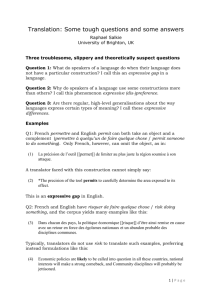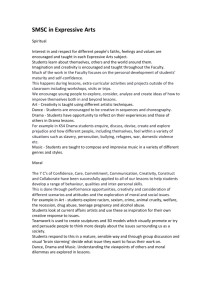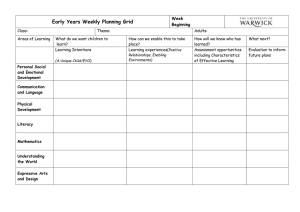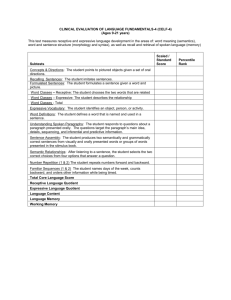Professional learning paper: Significant Aspects of Learning
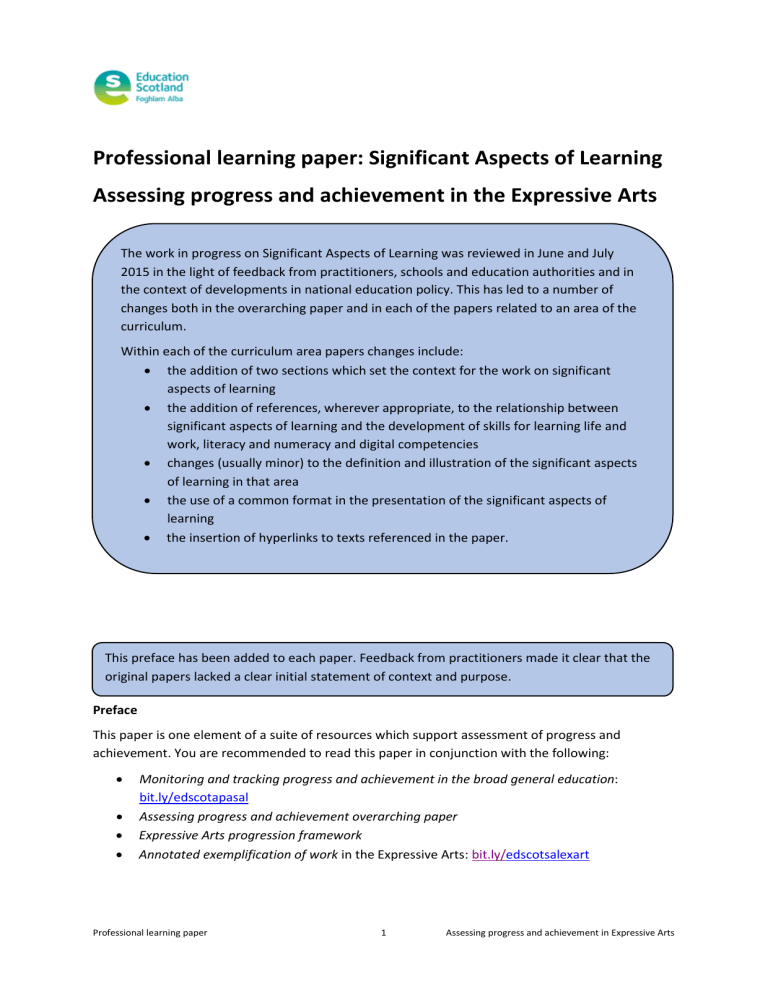
Professional learning paper: Significant Aspects of Learning
Assessing progress and achievement in the Expressive Arts
The work in progress on Significant Aspects of Learning was reviewed in June and July
2015 in the light of feedback from practitioners, schools and education authorities and in the context of developments in national education policy. This has led to a number of changes both in the overarching paper and in each of the papers related to an area of the curriculum.
Within each of the curriculum area papers changes include:
• the addition of two sections which set the context for the work on significant aspects of learning
• the addition of references, wherever appropriate, to the relationship between significant aspects of learning and the development of skills for learning life and work, literacy and numeracy and digital competencies
• changes (usually minor) to the definition and illustration of the significant aspects of learning in that area
• the use of a common format in the presentation of the significant aspects of learning
• the insertion of hyperlinks to texts referenced in the paper.
This preface has been added to each paper. Feedback from practitioners made it clear that the original papers lacked a clear initial statement of context and purpose.
Preface
This paper is one element of a suite of resources which support assessment of progress and achievement. You are recommended to read this paper in conjunction with the following:
• Monitoring and tracking progress and achievement in the broad general education : bit.ly/edscotapasal
• Assessing progress and achievement overarching paper
• Expressive Arts progression framework
• Annotated exemplification of work in the Expressive Arts: bit.ly/ edscotsalexart
Professional learning paper 1 Assessing progress and achievement in Expressive Arts
This resource supplements the Expressive Arts Principles and Practice paper and Experiences and
Outcomes. These can be found on the Expressive Arts homepage at: http://www.educationscotland.gov.uk/learningandteaching/curriculumareas/expressivearts/index.asp
The introduction to each paper has been revised as necessary to make clearer links to the
Principles and Practice paper which identifies the key aims of learning in the relevant curriculum area.
Introduction
The Expressive Arts Principles and Practice paper identifies the key aims of learning in the Expressive
Arts in the context of Curriculum for Excellence.
The expressive arts play a central role in shaping our sense of our personal, social and cultural identity. Learning in the expressive arts also plays an important role in supporting children and young people to recognise and value the variety and vitality of culture locally, nationally and globally.
Learning in, through and about the expressive arts enables children and young people to:
• be creative and express themselves in different ways
• experience enjoyment and contribute to other people’s enjoyment through creative and expressive performance and presentation
• develop important skills, both those specific to the expressive arts and those which are transferable
•
develop an appreciation of aesthetic and cultural values, identities and ideas and, for some, prepare for advanced learning and future careers by building foundations for excellence in the expressive arts.
This paper builds on this statement by making use of significant aspects of learning to support practitioners in carrying out dependable valid, reliable and challenging assessment of progress and achievement in Expressive Arts. This paper provides:
• a description of the significant aspects of learning within the Expressive Arts
• an outline of what breadth, challenge and application look like within the Expressive Arts
• information on planning for progression through curriculum levels, using breadth, challenge and application.
Professional learning paper 2 Assessing progress and achievement in Expressive Arts
The overarching paper in this professional learning resource contains a section on ‘What are the significant aspects of learning?’ Feedback suggested strongly that it would be helpful to practitioners as they refer to and use the curriculum area papers to have a slightly abridged version of this section included in each curriculum area paper.
What are significant aspects of learning?
Significant aspects of learning have been identified for each curriculum area. Each significant aspect of learning brings together a coherent body of knowledge and understanding and related skills, as outlined in the Principles and Practice paper and detailed in the Experiences and Outcomes. Each significant aspect of learning
• is common to all levels from early to fourth
• can provide sound evidence of learning in accord with the principles of Building the
Curriculum 5: A Framework for Assessment
• supports the practice of holistic (‘best fit’) assessment
• can be effectively used to inform assessment of progression within a level and achievement of a level
• can be used to plan further progression within a level and from one level to the next.
Using significant aspects of learning makes assessing progress and achievement more dependable and more manageable. This structure:
• supports practitioners in planning and integrating learning, teaching and assessment
• ensures that learners and practitioners can draw on a range of meaningful, robust, valid and reliable evidence from all four contexts of learning: classroom activities, interdisciplinary learning, the life and ethos of the school and personal achievements, including those outwith the school
• affords learners space to demonstrate the breadth of their learning, effective responses to challenging learning experiences and the ability to apply what they have learned in new and unfamiliar situations
• allows learners to progress by different routes and pathways through the experiences and outcomes
• helps practitioners avoid fragmented approaches to assessment which prevent learners from demonstrating the full range of their knowledge, understanding and skills
• removes the need to rely on evidence derived from single brief learning experiences or end of unit tests
• affords practitioners opportunities to plan and assess within a curricular area the development of the skills, attributes and capabilities required for learning, life and work, including the development of literacy, numeracy and digital competencies
Professional learning paper 3 Assessing progress and achievement in Expressive Arts
• supports practitioners in making holistic (‘best fit’) judgements about the achievement of a level either in an individual significant aspect of learning or, drawing on evidence from across the relevant significant aspects of learning, in a curriculum area.
The use of significant aspects of learning will inform:
• moderation activities based on holistic judgements supported by dependable evidence
• monitoring and tracking progress in learning
• quality assurance approaches
• the use of assessment to inform improvement at all levels of the education system.
A number of minor changes have been made in this section:
• the significant aspects are presented as a bold bullet pointed list
• numbering of significant aspects of learning has been removed; there were concerns that numbering could be interpreted as an order of priority
• minor changes have been made in the italicised text and to the final paragraph.
Significant aspects of learning in the Expressive Arts
Teachers and learners will focus on developing the knowledge and understanding, skills, attributes and capabilities detailed in the experiences and outcomes for each of the four components of the
Expressive Arts: Art and design, Dance, Drama and Music. Assessment in the Expressive Arts will focus on learners’ skills and abilities to express themselves through the three significant aspects of learning in each of the components:
• creating
• presenting
• evaluating and appreciating.
The significant aspects are common to each of the components.
By using significant aspects of learning, practitioners can plan and integrate learning, teaching and assessment in the most appropriate ways for children and young people in their own establishment. The following statements, under the headings of creating, presenting and evaluating and appreciating , should be considered at the planning stage, before setting up learning activities that will generate evidence of the learning to be assessed.
When creating , learners should have opportunities to:
• express themselves in different ways, think creatively, meet challenges positively and find imaginative solutions to problems
• develop knowledge and skills related to the different arts and broader skills such as the use of technology
• work cooperatively and communicate with others, and in so doing, show initiative,
Professional learning paper 4 Assessing progress and achievement in Expressive Arts
dependability, resilience, leadership and enterprise
• have opportunities to nurture and develop their expressive arts interests and skills
• work with professional performers or artists and other creative adults.
When presenting , learners should have opportunities to:
• perform and present for different audiences and be part of an audience for others
• demonstrate working collaboratively as well as learning independently
• experience enjoyment and contribute to other people’s enjoyment through creative and expressive performances and presentations
• establish links within the expressive arts components and the wider curriculum.
When evaluating and appreciating , learners should have opportunities to:
• analyse, explore and reflect on their own and other’s work and develop an enquiring mind
• draw on their own ideas, experiences and feelings, and through successful participation recognise the importance of the arts to the culture and identities of Scotland and other societies
• develop important skills and attributes, both those specific to the expressive arts and those which are transferable; this might include an appreciation of aesthetic and cultural values and identities.
For creating and presenting, the majority of activities will be practical and experiential, making use where appropriate of digital technology. Evaluating and appreciating are an integral part of the creative process and are linked to developing creative and performance skills, building new knowledge, understanding and enjoyment.
Learners may progress at different rates in different components and can achieve a level in one component of the expressive arts before doing so in others. For some, developing knowledge and understanding, skills, attributes and capabilities as part of a broad general education will prepare them for advanced learning and future careers paths.
Apart from the inclusion of references to ‘digital competencies’, there are no changes to this section.
What do breadth, challenge and application look like in the Expressive Arts?
Well-planned teaching and assessment in the expressive arts provides opportunities across the significant aspects of learning for learners to enjoy breadth, challenge and application in new and unfamiliar contexts. Learning in the expressive arts will be enriched by the use of digital technology, interdisciplinary learning, the life and ethos of the school and personalisation and choice within and outwith schools and settings. Learners will take an active part in planning, managing and assessing
Professional learning paper 5 Assessing progress and achievement in Expressive Arts
their learning, using high quality, relevant and challenging resources within a wide range of relevant and exciting themes.
Breadth
Breadth in the expressive arts relates to learners:
• demonstrating increasing skills and confidence in presentations and performances in familiar contexts, and through opportunities to practise
• demonstrating performing and communication skills in a range of contexts in art and design, dance, drama and music: this could include, for example, using skills to contribute to, and participate in: a fashion show; a choreography competition; a piece of musical theatre; work contributed as part of the making of a film
• using an increasing range of expressive arts vocabulary to describe their work: this will include the use of technical language learned such as: ‘design brief’; ‘dance sequence’;
‘chord progression’; ‘voice-over’ etc.
• using other people’s work and the work of their peers to extend their own understanding of expressive arts and the vocabulary that is specific to this area of the curriculum.
Challenge
Challenge in the expressive arts relates to learners:
• performing and presenting work in new settings or in contexts unfamiliar to them, including coping with the unpredictability of an audience response
• producing and performing increasingly complex pieces of work
• using digital technology to enhance public performances and to extend and develop ideas within creative learning
• showing increasing complexity and, where appropriate, detail and accuracy, in response to stimuli
• where appropriate, extending the length of presentations and creative responses, using skills, techniques and concepts suitable to the task and audience
• using an increasing complexity of processes and formats which may be unfamiliar and require learners to apply their previous knowledge and understanding in the expressive arts
• using increasing depth of analysis, including when using research, to arrive at deeper understanding of creating and presenting
• constructively evaluating their own work and that of others, and suggesting how it might be improved: this could include helpful annotations added by learners to, for example, scores, texts, sketches, or notes for dance plans.
Application
Application in the expressive arts relates to learners:
• using expressive arts skills in a range of situations such as: learner-led presentations and
Professional learning paper 6 Assessing progress and achievement in Expressive Arts
performances within the classroom and in the community; in school events, working with other establishments, including international partnerships, and through interdisciplinary learning
• applying their creative skills to produce and perform increasingly complex pieces of work and to recognise creativity and skills in the work of other people
• demonstrating an appreciation of how the expressive arts relates to the wider world and different cultures
• demonstrating an appreciation and understanding of cultural identities
• showing an awareness of the role and impact of expressive arts on people’s lifelong interest in, and enjoyment of, the arts.
There are a number of ways children and young people bring these aspects to life, including, for example, through e-twinning partnerships where they are sharing learning across borders. They also demonstrate practical application of skills through participation in themed interdisciplinary projects. These activities open up opportunities for learners to enjoy applying skills developed in the expressive arts and present them in a variety of ways in art and design, drama, dance and music. Staff should consider carefully how interdisciplinary opportunities can be linked to assessment of skills and attributes.
Learners demonstrate evidence of progress through their ability to apply their knowledge and skills in increasingly demanding and/or unfamiliar contexts, such as presenting beyond the classroom, and with other performers, sometimes in new settings. Examples of this might include:
• using skills to produce art work that demonstrates awareness of social issues; choreographies that show synthesis of ideas and influences; improvised drama capturing aspects of, for example, different historical eras; a musical performance drawing on a range of styles and cultures
• using creating skills to produce a sculpture for a public place; dance improvisation in response to new stimuli; a storyboard for a short play; a score for an animation
• using knowledge of the arts to produce a programme note, a poster advertising an event; a podcast; a dramatised news broadcast captured on video
• using presenting and performing skills to demonstrate a quality of learning, for example: in art and design, exhibit a folio of selected pieces of art work demonstrating application of techniques learned; in drama presenting a folio of selected drama performances in an appropriate format; in dance, demonstrating selected dance sequences; in music presenting a folio of selected pieces performed and recorded.
• discussing and appreciating the similarities and differences between composers’ works; artists’ paintings; actors’ performances; dancers’ performances.
Professional learning paper 7 Assessing progress and achievement in Expressive Arts
Apart from some development of text of the final paragraph, there are no changes to this section.
Planning for progression through breadth, challenge and application in expressive arts
Children and young people should be making progress in their knowledge, understanding, skills and attributes. They should have opportunities to demonstrate and record their latest and best in creating, presenting and evaluating and appreciating. Whenever possible and appropriate, consideration should be given to developing expressive arts skills in an integrated way, making the links between creating and performing and fostering a deeper understanding of these through evaluation and appreciation. By the end of a broad general education, learners’ performances and creative responses should show progress and demonstrate an increasing range of skills, as summarised below.
In art and design when learners are: creating, they will:
• create images and objects that demonstrate increasing accuracy of representation from direct observation
• independently select and apply media and techniques, demonstrating understanding of media properties through the images and objects that are created and the techniques and technology used. presenting , they will:
• demonstrate some understanding of how visual elements and visual concepts can be combined to create, for example, mood and atmosphere
• demonstrate understanding of creative and design processes through developing and communicating solutions to a design and/or expressive challenge. evaluating and appreciating, they will:
• select, process and present a variety of relevant research information from a range of sources
• through description and analysis, demonstrate knowledge and understanding of how artists and designers: handle media; use techniques and processes; use of visual elements and concepts
• demonstrate giving and accepting constructive comment about their own and others’ work in relation to agreed criteria.
In dance when learners are: creating, they will:
• demonstrate control and fluency by applying choreographic devices e.g. timing, direction, levels
• create dance sequences inspired by dance from different styles and cultures.
Professional learning paper 8 Assessing progress and achievement in Expressive Arts
presenting, they will:
• perform dance sequences inspired by dance from different styles and cultures
• demonstrate their knowledge from research information to enhance dance performance. evaluating and appreciating, they will:
• demonstrate giving and accepting constructive comment about their own and others’ work, including the work of professionals.
In drama when learners are: creating, they will:
• create and develop drama using stimuli (including text); the drama should be planned and structured for different purposes
• create a character and, in development, experiment with voice and movement techniques. presenting , they will:
• present dramas to an audience, portraying a range of distinctive sustained characters using dramatic techniques
• apply a range of voice and movement skills to enhance characterisation
• apply skills to enhance performance i.e. through a range of available theatre arts and technologies to create an appropriate atmosphere for the drama. evaluating and appreciating , they will:
• use a variety of media to evaluate and reflect on their work and the work of others, showing understanding of a range of drama techniques, and suggesting improvements using drama terminology
• demonstrate giving and accepting constructive comment about their own and others’ work, including the work of professionals.
In music when learners are: creating , they will:
• produce a composition/improvisation folio demonstrating use of melody, rhythm, harmony, timbre, structure, dynamics and music technology; compositions/improvisations will demonstrate skills acquired through performance. presenting, they will:
• perform music on at least two instruments/voice from a range of styles and cultures, demonstrating accurate pitch, melody, rhythm, timbre and dynamics
• use performance directions, musical notation and/or playing by ear
• demonstrate a musical flow with acceptable accuracy and sing/play in parts with clear diction, in tune and with good posture. evaluating and appreciating, they will:
Professional learning paper 9 Assessing progress and achievement in Expressive Arts
• evaluate and analyse music listened to from a range of styles and cultures, identifying features and concepts heard
• demonstrate giving and accepting constructive comment about their own and others’ work, including the work of professionals.
In each of the four components of Expressive Arts, practitioners should provide opportunities for children and young people to develop an awareness and increasing understanding of the role of professional arts companies and cultural organisations in society and the economy. As a result, learners should better understand how working in and through expressive arts develops important transferable skills for learning, life and work. These skills include being able to: analyse and evaluate their own work and the work of others; solving problems of increasing complexity; collaborate effectively; think and act creatively; use and develop digital competencies.
This section has been reworded to stress the value of using all elements of the professional resource: overarching paper, relevant curriculum area paper(s), progression framework(s) and annotated exemplification.
Next steps
Practitioners are encouraged to use this paper with the other elements of the professional learning resource to inform reflection on practice and plan for improvement as they support learners’ progress and achievement in learning. The professional resource, including this paper, can be used to stimulate, inform and support professional dialogue during quality assurance and moderation activities.
Professional learning paper 10 Assessing progress and achievement in Expressive Arts

